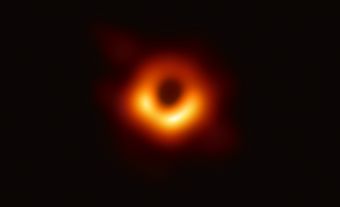Quasar
Quasar, a point-like astronomical object which radiates over a wide spectral range. Although the name is a contraction of a "quasi-stellar radio source", these objects also emit light, x-rays and even gamma rays. No quasar is visible to the unaided eye and even with large telescopes, quasars look like faint stars. Similar objects with no detectable radio emissions are referred to as radio-quiet quasi-stellar objects.
Quasars were not recognized as distinct entities until the early 1960s when attempts were made to identify radio sources whose positions had been accurately measured with radio interferometers. The optical spectra of these objects show much more light in the violet and ultra-violet than do stellar spectra. Doppler shifts in their optical spectra indicate that quasars are receding at very high velocities.
These high velocities imply that the objects are at great distances. Indeed, quasars are probably the most distant objects known. Quasars are also many times more luminous than normal galaxies and therefore are observable at much greater distances. They thus provide a means of studying large-scale structure of the universe. Quasars also provide an ideal frame of reference for precise geodetic measurements of the shape and motions of the Earth.
Many of the brightest quasars are surrounded by faint nebulosity which suggests that they are nuclei of galaxies. The Canada-France-Hawaii telescope has recently been used to produce images of these faint regions. After a quasar's point-like image has been subtracted the remaining image resembles an elliptical galaxy.
Canadian astronomers made the first direct measurements of quasar angular sizes using the now mothballed 46m Algonquin radio telescope in Ontario and the 26m radio telescope near Penticton, B.C. to form a long-baseline interferometer. Such radio measurements, combined with distance estimates inferred from optical spectra, indicate that quasars have higher intrinsic luminosities than any other objects. Measurements repeated over more than two decades show distinct structural changes in many quasars.
In some quasars, jets whose detailed structure changes from year to year, can be observed moving out from the nucleus at a very high velocity. Many quasars fluctuate in intensity with time scales of weeks to years. It is uncertain what causes these fluctuations; some may be intrinsic and some may be caused by gravitational bending of light.
To explain the source of energy in a quasar a supermassive black hole at its nucleus has been suggested. Direct evidence for this explanation has recently been observed in a nearby galaxy. Many explanations of remarkable quasar phenomena remain tentative so the study of quasars is still one of the most challenging branches of astronomy.

 Share on Facebook
Share on Facebook Share on X
Share on X Share by Email
Share by Email Share on Google Classroom
Share on Google Classroom


